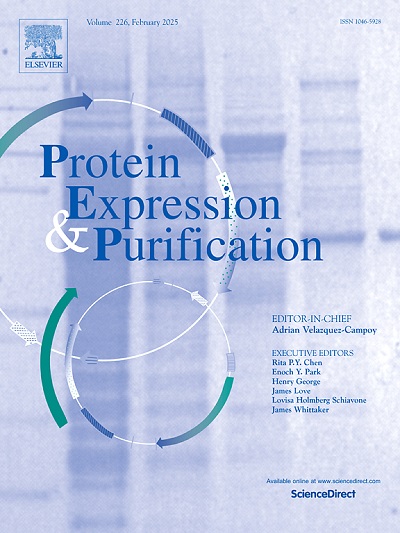Nature of recombinant human serum amyloid A1 in Escherichia coli and its preferable approach for purification
IF 1.2
4区 生物学
Q4 BIOCHEMICAL RESEARCH METHODS
引用次数: 0
Abstract
Serum amyloid A1 (SAA1) is an apolipoprotein which is involved in amyloid A amyloidosis (AA) by forming fibrils. The process of fibrillation is still being explored and holds challenges in recombinant expression and purification of SAA1. This study deals with the preferable approach for the expression and purification of SAA1 which is normally toxic and unstable to express without using any fusion-tag. Complete soluble expression of SAA1 was obtained without the use of additional tag, in terrific broth, supplemented with 3 % ethanol at 30 °C. Soluble fraction of SAA1 was initially treated with salting-out using ammonium sulphate giving 1.5 M salt concentration to avoid SAA1 protein precipitation along with unwanted proteins. The soluble fraction of SAA1 after salting-out was purified by two individual chromatographic approaches: One anion exchange and second reverse phase chromatography. The yield of purified SAA1 was 3 times greater by anion exchange than reverse phase chromatography. MALDI-TOF analysis of purified SAA1 showed 11813 Da for intact protein and proteome analysis revealed greater than 90 % sequence coverage by MASCOT. The subunit interaction showed hexamer form at basic pH which was analyzed by size exclusion chromatography. The fibrillation activity of SAA1 was found to be 10–15 times higher in basic media at 43 °C than 37 °C. Our research demonstrates successful expression and purification of wild-type human recombinant SAA1. The cost-effective radical approach employed for purification of SAA1 is crucial for thorough protein characterization particularly, mechanisms of protein aggregation involved in amyloidosis.
重组人血清淀粉样蛋白 A1 在大肠杆菌中的性质及其最佳纯化方法。
血清淀粉样蛋白 A1(SAA1)是一种脂蛋白,通过形成纤维参与淀粉样 A 淀粉样变性(AA)。纤化过程仍在探索之中,这给 SAA1 的重组表达和纯化带来了挑战。SAA1 通常具有毒性且不稳定,因此在不使用任何融合标记的情况下,表达和纯化 SAA1 是一种可取的方法。在添加了 3% 乙醇的特氏肉汤中,温度为 30 °C,在不使用额外标签的情况下,获得了 SAA1 的完全可溶性表达。SAA1 的可溶性部分最初用硫酸铵盐析处理,盐浓度为 1.5 M,以避免 SAA1 蛋白与不需要的蛋白质一起沉淀。盐析后的 SAA1 可溶性部分通过两种不同的色谱法进行纯化:一种是阴离子交换法,另一种是反相色谱法。阴离子交换法纯化的 SAA1 产量是反相色谱法的 3 倍。纯化的 SAA1 的 MALDI-TOF 分析显示其完整蛋白质的含量为 11813 Da,蛋白质组分析显示 MASCOT 的序列覆盖率超过 90%。亚基相互作用在碱性 pH 下呈现六聚体形式,并通过尺寸排阻色谱法进行了分析。研究发现,SAA1 在 43 °C 的碱性介质中的纤化活性是 37 °C 的 10-15 倍。我们的研究成功地表达和纯化了野生型人类重组 SAA1。纯化 SAA1 所采用的经济有效的激进方法对于彻底鉴定蛋白质,特别是淀粉样变性所涉及的蛋白质聚集机制至关重要。
本文章由计算机程序翻译,如有差异,请以英文原文为准。
求助全文
约1分钟内获得全文
求助全文
来源期刊

Protein expression and purification
生物-生化研究方法
CiteScore
3.70
自引率
6.20%
发文量
120
审稿时长
32 days
期刊介绍:
Protein Expression and Purification is an international journal providing a forum for the dissemination of new information on protein expression, extraction, purification, characterization, and/or applications using conventional biochemical and/or modern molecular biological approaches and methods, which are of broad interest to the field. The journal does not typically publish repetitive examples of protein expression and purification involving standard, well-established, methods. However, exceptions might include studies on important and/or difficult to express and/or purify proteins and/or studies that include extensive protein characterization, which provide new, previously unpublished information.
 求助内容:
求助内容: 应助结果提醒方式:
应助结果提醒方式:


